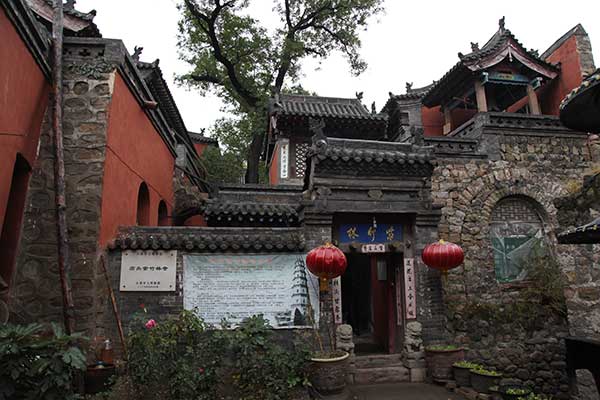An underground battleground
Updated: 2015-12-21 08:36
By Li Yang/Sun Ruisheng(China Daily)
|
||||||||
 |
|
The once-abandoned village is now a popular tourist attraction.[Photo by Sun Ruisheng/China Daily] |
Diantou's caves were carved to enable imperial soldiers to vanquish invaders without leaving their subterranean fortifications. Li Yang and Sun Ruisheng explore these little-known grottos and tunnels in Taiyuan.
Diantou village's honeycomb of ancient cave dwellings conjures an allure that today draws a diverse cast of characters-adventurers, painters, photographers, architects, military-history fans, archaeologists, filmmakers, historians, monks, Taoists, anthropologists and shepherds.
The complex of caverns is whittled into the mountainsides over a 1-kilometer stretch overlooking a river that runs parallel to the main road connecting Taiyuan, which today is Shanxi's provincial capital, to the outside world.
Its function was military-hence, the caverns are all within arrow's reach of the road-since the frontier garrison was long the frontline of skirmishes between agricultural and nomadic civilizations.
The fortifications were first chiseled into the slopes in the late Western Jin Dynasty (265-316) to protect the ancient city of Jinyang from Hun invaders from the north. It mostly remained a garrison until the Qing Dynasty (1644-1911), when the Manchurians subjugated the grasslands' herding tribes.
The grottos lodged villagers from then until 2001, when they relocated into modern housing.
It was essentially abandoned until Diantou Tourism Development Co manager Li Guihu explored the settlement in 2008.
"I'd heard of the village long ago," he recalls.
"I was astonished to discover its potential tourism appeal when I finally visited."
Li signed a contract with the local government to establish a tourism venture to "protect, rather than develop, the village".
- Wuzhen : ancien village devient plus intelligent
- Nanyang's ancient town becomes 'painter village'
- Sanmenxia's village receives provincial honor
- A visit to 800-year-old Peitian ancient village in Fujian
- Hollowed out village in NE China and the left-behind elderly
- Remote village stays faithful to feng shui rules
- 10 execs suspected of faking pollution data
- Top 10 social media events of 2015
- Life sentences for east China child traffickers
- Shenzhen leaps to top of efficiency list in 2 yrs
- Pandas prefer choosing their own sex partners, researchers find
- Tycoons exchange views on building a cyberspace community of shared future
- Iraq holds its first beauty contest in 40 years
- Libyan factions sign UN deal to form unity government
- World's refugees and displaced exceed record 60 million
- No specific, credible terror threats against US: Obama
- UN Security Council adopts resolution to cut off Islamic State funding
- California shooters' ex-neighbor charged with supporting terrorists

 Iraq holds its first beauty contest in 40 years
Iraq holds its first beauty contest in 40 years
 Highlights at the Light of the Internet Expo
Highlights at the Light of the Internet Expo
 Finger Icons: Guess who's who
Finger Icons: Guess who's who
 Older mother who lost only child delivers another baby
Older mother who lost only child delivers another baby
 Top 10 most attractive FDI destinations in the world
Top 10 most attractive FDI destinations in the world
 Canadian college offers flying classes to legless girl
Canadian college offers flying classes to legless girl
 Fashion buyer scours the world for trendy items
Fashion buyer scours the world for trendy items
 Tycoons exchange views on building a cyberspace community of shared future
Tycoons exchange views on building a cyberspace community of shared future
Most Viewed
Editor's Picks

|

|

|

|

|

|
Today's Top News
Shooting rampage at US social services agency leaves 14 dead
Chinese bargain hunters are changing the retail game
Chinese president arrives in Turkey for G20 summit
Islamic State claims responsibility for Paris attacks
Obama, Netanyahu at White House seek to mend US-Israel ties
China, not Canada, is top US trade partner
Tu first Chinese to win Nobel Prize in Medicine
Huntsman says Sino-US relationship needs common goals
US Weekly

|

|








